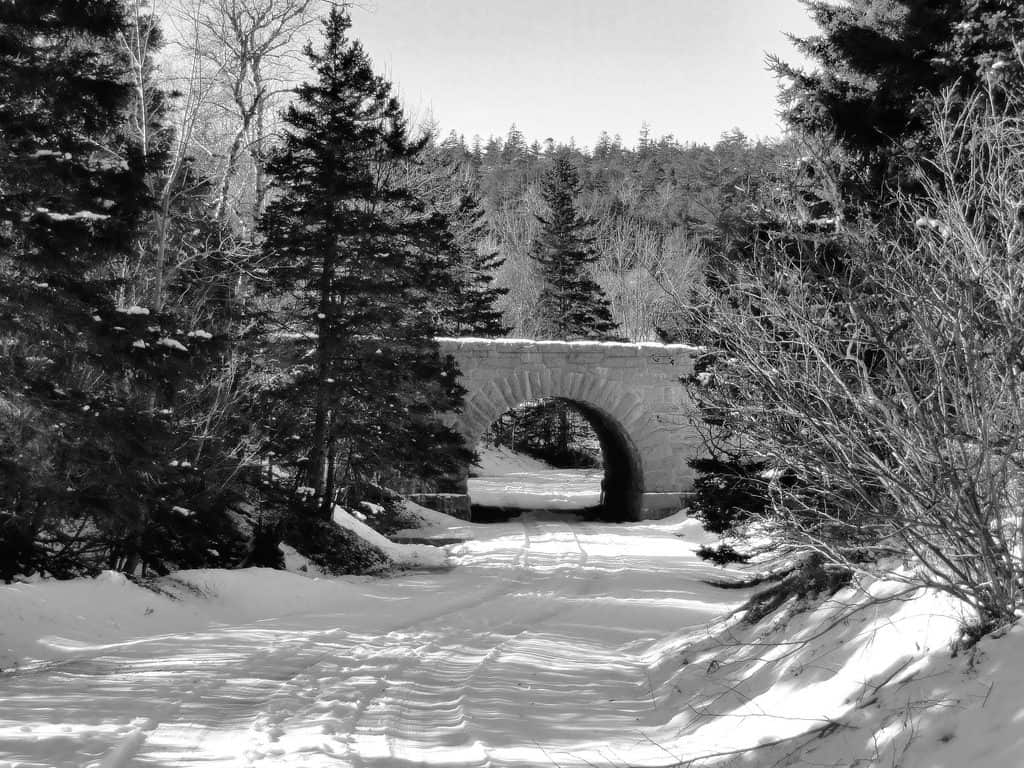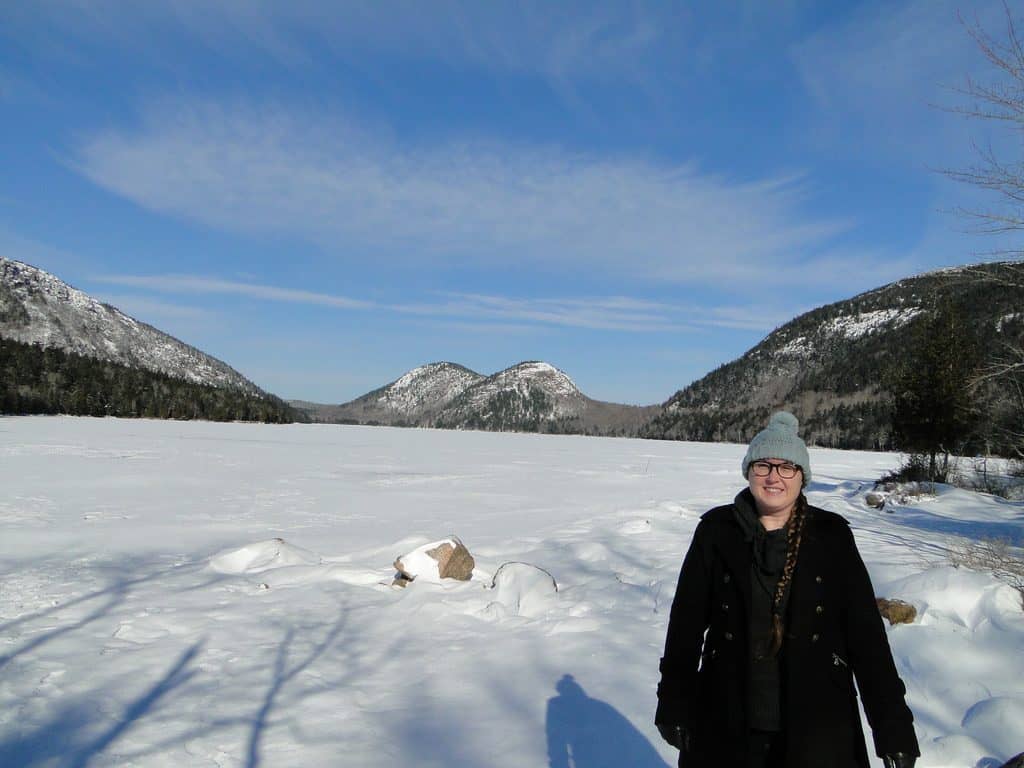
Written by Stephen Ondich
Winter and snow are not what most people think of when you mention Acadia National Park. More likely, Summer fun or Fall foliage comes to mind. However, Acadia is open throughout the Winter season and there’s lots of cold weather activites to see and do.

Winter in Acadia National Park
Acadia National Park is open in the winter with many activities for those who enjoy snow with their outdoor fun. Use the 45 miles of carriage roads (31 of which are groomed) and unplowed park roads.
Many people do not even realize the park is open during the winter. It is a great time to see the Acadia National Park if you are looking to see the park without the normal crowds.
The number one complaint about Acadia in the Summer is the crowds. You can find solitude in the Winter months
Of course, there is a reason why the park is not teaming with crowds. It has to do with the temperatures. However, there is something to be said for being one of her small group of people enjoying a winter wonderland.
If you need an additional incentive to come to Acadia in Winter, the park offers free admission.
The information in this article is based on past park operating information. Conditions change from year to year. Always check the park website to confirm current information on seasonal road closures and other important visitor information before heading over to Arcadia.
Winter Accessible Park Roads
Park roads that are open include:
Ocean Drive
Jordan Pond Road
Sergeant Drive
Winter Park Road Closures
Much of Park Loop, Road is closed during the winter except for the Ocean drive and Jordan pond road areas.

Winter Gear You Should Bring to the Park
- Snowshoes. Avoid the hiking trails when wearing snowshoes as the ice can be dangerous.
- Hiking poles. Poles help keep you balanced when traversing frozen or wet trails. They are also a good tool to test the ice when crossing a frozen body of water. If you are carrying heavy backpack, over sloping trails they will improve your stability.
- Warm hats.Wool hats are warmer than synthetic hats. However, synthetics are lighter and dry faster than wool. Consider a hybrid hat for the best of both materials.
- Warm clothes. Dress in layers.
- Headlamp. Bring a water-resistant one with rechargeable batteries.
- Gloves. Don’t leave these at home. Seriously.
- Trail crampons for shoes. Slips and falls can cause serious injuries. Crampons provide additional traction to protect against challenging winter surface conditions.
Popular Winter Activities in Acadia
Cross country skiing
Take advantage of the 45 miles of carriage roads to cross country ski your way across Acadia national Park. When the snow is heavy enough you may find ski tracks laid down by volunteer organizations. Another Great area to cross country ski is on the parks unplowed roads. However, keep an eye out for snowmobiles which are also permitted on the unplowed Park roads.
Winter Hiking
Many people have never considered taking to the parks trails during winter. You can do this. However you will be I can on ice and snow. Member to bring your truck and pole. For safety considerations, stay away from the parks more challenging trails. I believe they are still open but they are difficult enough to navigate in the summer months.
Snowy Owl Watching
Granted, a good percentage of Acadia’s wildlife is in hiding during the winter. However, there are unique wildlife viewing opportunities if you are willing to brave the elements.
Snowy Owls have been spotted in Cadillac Mount and Sargent Mountain.
Although sightings are somewhat rare, the Snowy Owl is a spectacular creature to observe. It is North America’s largest owl, sometimes weighing up to 6 pounds. Also, it’s unusually thick feathers provide warmth and insulation in the owls’ preferred cold weather climate.
Check out the eBird Range Map to see the locations of Snowy Owl sightings within Acadia.
Snowmobiling
If you want to enjoy driving The length of Park Loop, Road during winter, snowmobiles are allowed. Check out the park map to see all available snowmobile routes. However, most of the carriage roads are off-limits to snowmobiles as well as hiking trails.
All Maine Snowmobile laws are enforced within Acadia. You will need to bring your own snowmobile as rentals are not available.
Winter Photography
The winter months provide a great opportunity to photograph some of the park’s iconic locations against a backdrop of white snow. However, there are a few items that you should bring.
- A large plastic freezer bag. Before you come inside from the cold, place your camera inside a sealed plastic bag for two hours. Doing this will prevent harmful condensation buildup on your lenses.
- Bring extra batteries. Cold air shortens the life of batteries. Make sure to bring extra and keep them out of the elements.
- Use a graphite tripod. Graphite tripods are lighter than metal and will not freeze your hands.
- Use a quick release plate for your camera.Screwing and unscrewing the camera from your tripod is exponentially more difficult when your hands are refrozen. A quick release plate saves your sanity.
If you need some winter photo inspiration, check out this amazing Acadia winter imagery.
Watching the Sunrise
Cadillac Mountain is the first place to see daylight in winter. It is closed to car traffic in the winter but you can hike up. When you reach the peak, expect temperature almost 20° cooler than below. Keep in mind that’s coming from already frigid winter temperatures at the mountain base.
If you haven’t already read it, check out our 7 Critical Cadillac Mountain Sunrise Hike Tips.
Winter camping
Head over to Blackwood Campground if you want to actually stay in camp in the park during the winter months. Blackwoods campground is the only campground in Acadia national Park that is open 365 days a year. In order to take advantage of the sole winter campground in Acadia, you will need to get a camping permit from the park. The good news is the camping permits are free!
Even though Blackwoods campground is open during the winter, the road that leads to it is not open to vehicle traffic. That means you will be required to you hike about 1 mile to arrive at the campground.
Naturally, you will want to park as close as possible to the campgrounds. So will everyone else. There is a limitation of one vehicle per group at the Blackwoods campground gate.If you have a second vehicle you can bring it but you need to leave it at the hulls cove visitor center.
Unfortunately, you cannot use a snowmobile to Drive directly to the campsite either. Snowmobiles are not permitted in the Blackwoods campground area of the park.
You must camp on established Blackwoods campsites. If you’re out in mid winter, you’re already roughing it enough in my opinion!
Primitive camping only.
Primitive camping is camping with little to no amenities or infrastructure. Be prepared to carry your equipment to the designated camp area.
Porta potty‘s are available at the campground but you need to Provide your own toilet paper.
One hand pump is available for water.
Due to the lack of amenities, you will carry in more supplies than you need at a traditional campsite.
As a rule of thumb, your backpack should not exceed 25% of your body weight. Remember, it’s a 1 mile hike from the parking area to your campsite.
Keeping Warm
Did I mention winter is cold in Acadia?
Most winter weather campers know to layer their clothing to optimize warmth.
Body heat comes from your core and your hands and feet are as far away from your core as you can get. Hence, the term extremities.
When your core cools down, it pulls blood from your extremities. Keeping your core warm means that your hands and feet are likely to also stay warm.
When hiking in cold temperatures layer gloves on your hands for warmth just like you layer clothes. Use a liner glove as the first layer of heat and moisture protection. Then wear an insulating glove on top. That glove combination provides a dual defense against the harsh winter elements.
Ice fishing
During the months of January through March, you can joy the time honored tradition of ice fishing in Arcadia.
All of the species of fish that are caught in the Summer months can also be caught in the winter.
Make sure that you have all of your permits in order.
Always use caution and commonsense.
Just because the park allows icefishing does not mean all of the frozen ponds and lakes are safe to walk on.
As relaxing as fishing is, resist the temptation to ice fish in Acadia by yourself. If you end up in the water, hypothermia sets in fast. Without assistance to get out of the water your risk of drowning is high.
Don’t forget the ice fisherman’s #1 safety tool, ice rescue claws.
What Happens When You Fall Through the Ice?
Initially, your body goes into shock for the first few minutes. Some people describe a searing pain which disrupts the communication between your brain and your muscles. Shortly thereafter, hyperventilation sets in. If you panic, the result can be fatal.
What Should You Do If You Fall Through Ice?
Don’t panic. It’s hard to remain calm when you’re battling the effects of hypothermia. However, try to control your breathing and focus on keeping your head above water.
Find your way back. Maneuver your way over to the place where you fell into the water. If it held your weight prior to the fall, there is a good chance of finding solid ice again.
Slither like a snake. After locating a solid platform of ice, Pull yourself up while staying horizontal and keeping your body as spread out as possible. Kick your legs to generate momentum. The purpose of staying spread out like a snake is to avoid putting a lot of weight on any one area of the ice. If you brought ice claws, time to break them out!
Roll Off the Ice. Resist the urge to stand up and walk (or run) off the ice. Rolling off will keep your weight distributed. Remember, the ice broke once. It may be weak in other places. Also, you may lack the energy and wherewithal to survive a second fall.
How To Help Someone Who Fell Through the Ice.
Don’t panic. If you see someone fall through ice, keep your wits and do not run toward them. Otherwise, you may be joining them.
Quickly call for help. If you have a cell phone, call 911 while keeping an eye on the victim. Do this as quickly as possible so you can proceed to administer aid.
Encourage. Reassure the victim that you know what to do in this situation, Encourage them to remain calm and slow their breathing.
Tell them what to do. Tell the victim how to get out of the water using the steps above.
Throw them a line. The victim may be unable to get out of the water on their own. If that is the case, find a rope, cord or long stick and throw it toward the victim while holding the other end.
Make a Human Chain. If none of the above tools are at your disposal, form a human chain. Each person lies on their stomach (to disperse weight) and holds onto the ankles of the person in front of them. Although this method requires the rescuers to go on the ice to get close to the victim, the risk is mitigated.
Winter driving
If you are like me, you may prefer to enjoy snow scapes of Acadia from the comfort of a heated automobile. I know, I’m no fun.
Here are three popular winter driving routes:
Ocean Drive. Enjoy this 2 mile stretch along the coast, beginning at Schooner head Road and ending at otter Cliff Road. It’s a perfect time to watch the crashing waves of Thunder Hole without any company. This is a one-way route.
Jordan Pond Road. You can enter Jordan Pond Road at Seal Harbor. The Stanley Brook entrance is gated for Winter. Take Jordan pond road to Park Loop Road. This is a two-way route.
North East Harbor. From route three, take Sergeant drive to you enjoy the winter scenery Somes Sound and North East Harbor. Keep an eye our for spectacular ice formations along the road’s rock walls.
A park map showing winter driving access roads can be found here.
Attend the Acadia Winter Festival
- Guided snowshoe and cross-country ski trips
- Snow shelter building workshops
- Ice sculpture demonstrations
- Birding Excursions
- Nocturnal owl prowl
Although dates vary from year to year, the festival typically takes place between February and March out of the Schoodic Institute. Check their website for current information.
Pingback: Milbridge, Maine: A Helpful Guide - Maine Terrain
Pingback: Cozumel Pearl Farm: Can You Tour A Working Pearl Farm? Yes, We Did.
Pingback: 🌄 Building Their Coastal Maine Dream Home - Maine Terrain
Pingback: 🌄 Tripod: Budget Option for Acadia Photography - Maine Terrain
Pingback: 🌄 7 Critical Cadillac Mountain Sunrise Hike Tips - Maine Terrain
Pingback: 🌄 Maine Outdoor School: Connecting Down East Students With Nature -
Pingback: What Size is a Moose? - Maine Terrain
Pingback: Moose Size: How Big Are They? - Maine Terrain
Pingback: 🌄Popovers: Can You Make Them Jordan Pond-Style? - Maine Terrain
Pingback: 🌄Bringing Back the Milbridge Theatre - Gateway Milbridge Interview 2019
Pingback: 🌄John Walters: Codfish, Milbridge and Sports Illustrated - Maine Terrain
Pingback: 🌄Can Your iPhone Take a Good Nature Picture? - Maine Terrain - 2019
Pingback: 🌄 Goat Hikes in Maine: Where Baby Goats Live and You Hike - 2019
Pingback: Acadia National Park: 2 Secret Things to Do - Maine Terrain
Pingback: 🌄 Acadia National Park - Secret Places - Hidden Spots - Maine Terrain
Pingback: 🌄Drone's Eye View: Ryan Malagara films Down East -Maine Terrain-2019
Pingback: Downeast Maine Pumpkin Bread! - Maine Terrain - 2019
Pingback: The Best Coastal Town in Maine - Maine Terrain